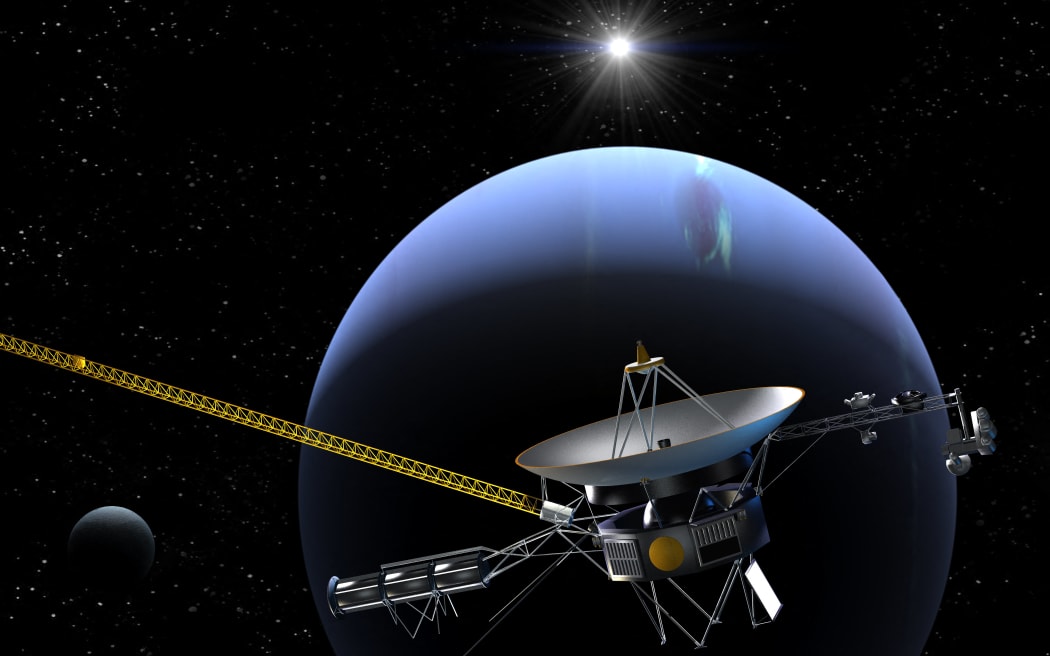
Voyager 2 passing Neptune and one of its moons, Triton, before leaving our solar system in 1989. Photo: STEVEN HOBBS / NOVAPIX / AFP
If there is life on other planets, what might it look like, and would they even bother coming to Earth?
Lisa Kaltenegger director of the Carl Sagan Institute, Astronomy & Planetary Science, at Cornell University in New York State, and author of Alien Earths.
She is coming to New Zealand next year as a guest of the Royal Astronomical Society of New Zealand to deliver the Beatrice Hill-Tinsley lecture.
Kaltenegger is an expert in modelling potential habitable worlds and their detectable spectral fingerprint. Her research focuses on rocky planets circling other stars, looking at potentially Earth-like exoplanets in the Habitable Zone.
She told Jim Mora on Sunday Morning that the there are a good chance there were other habitable worlds out there.
"We know that one in five stars has a planet just the right distance (and) just the right size that it could potentially be like our own Earth. And we don't know if it is, but our galaxy alone - The Milky Way - has 200 billion stars, so I would say the odds are in our favour!"
We should assume that the universe is teeming with life, but it was tricky and expensive to reach other worlds - and Earth might not be aliens' first choice of destination.
"If you had to pick, would you really pick us, yet? I wouldn't choose us, I would choose a civilisation that's 5000-year older and try to learn something from them, if they're out there."

Lisa Kaltenegger is coming to New Zealand next year to deliver the Beatrice Hill-Tinsley lecture. Photo: Carl Sagan Institute
Kaltenegger said she was optimistic about Earth's future, especially the way in which countries like New Zealand were looking after the environment.
"And that's what we need to protect... Earth (is)... kind of a huge spacecraft, the biospheres are our life support system and we need to protect that and if we do, we have a chance to make it to the future."
Kaltenegger's team at Cornell University uses technology to gather, grow and inspect microbes in the laboratory, looking at how micro organisms reflect light.
The information taken from a spectrograph was used to investigate what a telescope might see if there were not green plants on other planets, and to ensure scientists were not missing signs of life elsewhere.
"What about if it were a planet with lots of hot springs, or what it was a planet that was an ocean world covered with algae - how could we not miss signs of life?"
So what have scientists seen in the planets scanned so far? How many of those are inhabitable?
Within our galaxy, she said there were about 35 planets just the right distance from their stars and small enough to sustain life - "not too hot, not too cold" - but telescopes were not yet precise enough but find them, "but know they're out there".
Such a "small rock in space" needed to get just the right amount of heat from its star, she said. "That water could be liquid on the surface, and on the Earth we know that all life that we know of needs liquid water to strive, to exist, to evolve; then we say these are our best bets.
"One planet is as habitable or uninhabitable as the other until we can point our telescopes at it and figure out what's in the air, because each planet has a kind of light fingerprint that tells you what its air is made out of."
Thanks to the James Webb Space Telescope, we now had a big enough telescope to catch that life from these small planets, she said.
So what specifically are they looking for?
"We're looking for gases that are produced by light that we cannot explain other than (as a sign of) life ... the combination of oxygen or ozone with a reducing gas like methane.
"Something could produce methane that is not life - methane alone is not a signature. Also, you could split water or split CO2 and get quite a bit of oxygen but if oxygen and methane are at the same time in your air, they react very fast to CO2 and water so when you see them together ... that tells you that both are being produced right now in big amounts and that combination is what ... leads us to infer that has to be life in this other world."
If we on Earth have struggled to reach alien worlds, couldn't the reverse be true? Wouldn't aliens need wormholes or tunnels to get to us?
"Every contact that we envision is, by definition, limited by the technology we have (or)... imagine," she said.
"There's probably other means of contact... of travel ...of saying hello to someone that we haven't come across yet, because we're just not at that (stage of) evolution.
"Once we're there, we're like, 'Of course they used this! They didn't come with spaceships!"
Just because we couldn't detect life by listening to radio signals, it didn't mean there was nothing out there.
"Our technology is changing so fast that if you just envision what it could be in the future... I think we're just not there yet."
So with the size and power of the James Webb Space Telescope, are we now on the cusp of ever greater space discoveries?
"A telescope is kind of like a bucket in the rain: the bigger you can make it, the more rain it will have caught in one downpour.
"This is where the size of the James Webb Space Telescope is our key to being able to now do this for small, earth-like planets... it gives us a big enough tool to investigate the first of these rocky worlds.
"We could get lucky, or it could take some time!"

Photo: MARK GARLICK/SCIENCE PHOTO LIBRA
There had been a lot of change in the Earth's atmosphere over time, and dinosaurs had lived during a "sweet spot" when the oxygen was at 30-35 percent - a point just before "you have fires that extinguish everything", she said.
Could there be invertebrates lurking in an oxygen-methane mire in other worlds?
If so, they were likely to be peaceful civilisations, she said.
"If you can survive in the long run, you probably have to figure out how to live in peace with every other species on your planet.
"There could be giant sponges that are peacefully mumbling something we don't understand ... there is such ... an exciting diversity out there... or probably (something scary) or not scary and some of the scary comes from us not understanding what we are seeing."
Jim Mora asked Kaltenegger about the iconic 'pale blue dot' image of Earth taken from the Voyager I mission, and Carl Sagan's description of Earth as "a mote of dust suspended in a sunbeam".
"I don't want to be special and alone; I'd rather be a little bit more common but have a lot of friends to talk to."
That image was a turning point in her career, she said.
"Seeing that dot on the huge, vast, blank canvas of space... this tiny bright beautiful dot - our home - it changed how I viewed the earth and how I view my responsibility to take care of it."
Eventually, in around 500 million years, the Sun will get so bright that Earth's oceans will start to evaporate, and liquids start to boil.
"So is it our destiny to travel the stars? If you take the long view on humankind, absolutely."

